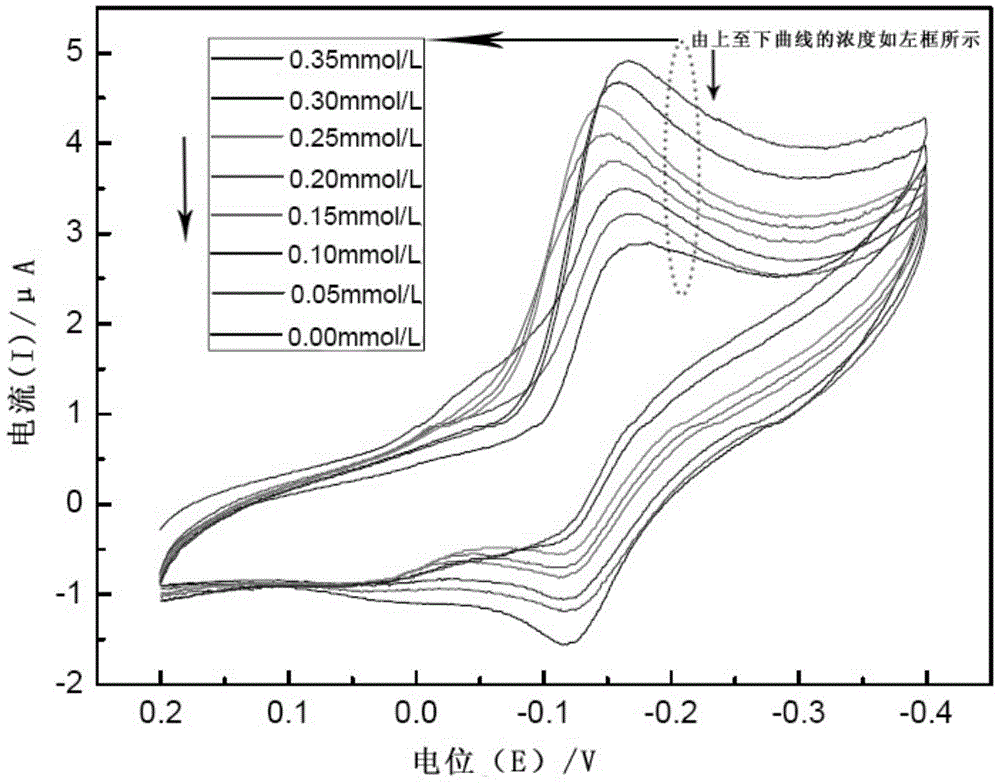Enzyme biosensor for detecting cholesterol as well as preparation method and application of biosensor
A biosensor, cholesterol oxidase technology, applied in the field of electrochemical biosensors, to achieve good electron transfer, good embedding effect, and good selectivity
- Summary
- Abstract
- Description
- Claims
- Application Information
AI Technical Summary
Problems solved by technology
Method used
Image
Examples
Embodiment 1
[0040] An enzyme biosensor for detecting cholesterol, the schematic diagram of the overall structure is shown in figure 1 As shown, it consists of a reference electrode 2, a counter electrode 3 and a modified working electrode 1; the cross-sectional schematic diagram of the modified working electrode 1 is shown in figure 2 As shown, the modified working electrode 1 is composed of a working electrode 1-1 and a material recognition enzyme film 1-2 solidified on the surface of the working electrode, wherein the material recognition enzyme film 1-2 is mainly composed of graphene, sulfur Corydalis, cholesterol oxidase, horseradish peroxidase and chitosan are mixed and prepared;
[0041] The substance recognition enzyme membrane 1-2 is obtained by taking 1-5 mg / mL graphene-chitosan solution, 5-10 mmol / L thionine aqueous solution, 20-30 mg / mL cholesterol oxidase aqueous solution and 10-20 mg / L mL of horseradish peroxidase aqueous solution was mixed and then dried;
[0042] Prefera...
Embodiment 2
[0046] A kind of enzyme biosensor for detecting cholesterol, its preparation method is as follows:
[0047] (1) Take 5g flake graphite and 2g NaNO 3 For mixing, add 120mL concentrated sulfuric acid, place in 4°C ice-water bath and stir for 30min; then add 20gKMnO 4 , magnetically stirred and reacted for 60 minutes, then moved into a warm water bath at 40°C and continued to react for 30 minutes; then added 230mL of distilled water, stirred at a temperature of 95°C for 5 minutes, then added hydrogen peroxide with a mass fraction of 5%, until no bubbles were generated, filtered while hot, And use deionized water and 5% hydrochloric acid for multiple washings; then dialyze for one week, then dry in a vacuum oven at 60°C to obtain graphite oxide; weigh 0.1g of the graphite oxide and dissolve it in 50g of distilled water, ultrasonically 60min to obtain a stable graphite dispersion; heat the graphite dispersion to 80°C and add 2mL of hydrazine hydrate dropwise, filter after reacting...
Embodiment 3
[0059] A kind of enzyme biosensor for detecting cholesterol, its preparation method is as follows:
[0060] (1) Take 5g flake graphite and 2g NaNO 3 For mixing, add 120mL concentrated sulfuric acid, place in 4°C ice-water bath and stir for 30min; then add 20gKMnO 4 , magnetically stirred and reacted for 60 minutes, then moved into a warm water bath at 40°C and continued to react for 30 minutes; then added 230mL of distilled water, stirred at a temperature of 95°C for 5 minutes, then added hydrogen peroxide with a mass fraction of 5%, until no bubbles were generated, filtered while hot, And use deionized water and 5% hydrochloric acid for multiple washings; then dialyze for one week, then dry in a vacuum oven at 60°C to obtain graphite oxide; weigh 0.1g of the graphite oxide and dissolve it in 50g of distilled water, ultrasonically 60min to obtain a stable graphite dispersion; heat the graphite dispersion to 80°C and add 2mL of hydrazine hydrate dropwise, filter after reacting...
PUM
 Login to View More
Login to View More Abstract
Description
Claims
Application Information
 Login to View More
Login to View More - R&D
- Intellectual Property
- Life Sciences
- Materials
- Tech Scout
- Unparalleled Data Quality
- Higher Quality Content
- 60% Fewer Hallucinations
Browse by: Latest US Patents, China's latest patents, Technical Efficacy Thesaurus, Application Domain, Technology Topic, Popular Technical Reports.
© 2025 PatSnap. All rights reserved.Legal|Privacy policy|Modern Slavery Act Transparency Statement|Sitemap|About US| Contact US: help@patsnap.com



